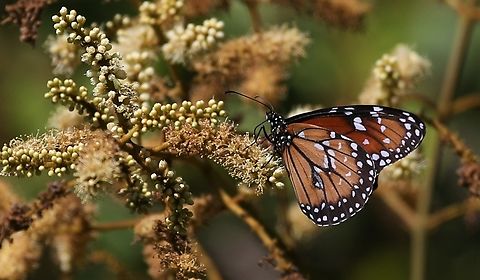
Appearance
The upperside of the wings is dark reddish brown with the forewing sometimes having white submarginal spots. The veins are lightly marked with black. Males have a black scent patch on each of the hindwings. The underside of the wings is also dark brown with a postmedian band made up of squarish spots. The soldier has a wingspan of 2+1⁄2 to 3+1⁄2 inches. "D. e. flexaure", formerly "D. flexaure", is a subspecies which has more white markings on the hindwing underside.Naming
Similar species in the soldier's range include the monarch and the queen.The monarch is more orange, has heavier black-lined veins, and the underside of the wings is a pale yellowish color.
The queen has nearly no black-marked veins, and has white forewing submarginal spots on both surfaces of the wings.
Behavior
Males patrol for females. The eggs are bright orange. The black larva is banded with white and yellow stripes. It has a subdorsal row of yellowish-tan spots. There are six black, fleshy filaments, the first pair near the head, the second on the thorax, and the third at the end of the abdomen. The chrysalis is very similar to that of the monarch, often indistinguishable. It has three or more broods per year.Habitat
The soldier may be found in a variety of open, subtropical habitats such as citrus groves, weedy water edges where host plants occur, dry fields, etc.References:
Some text fragments are auto parsed from Wikipedia.